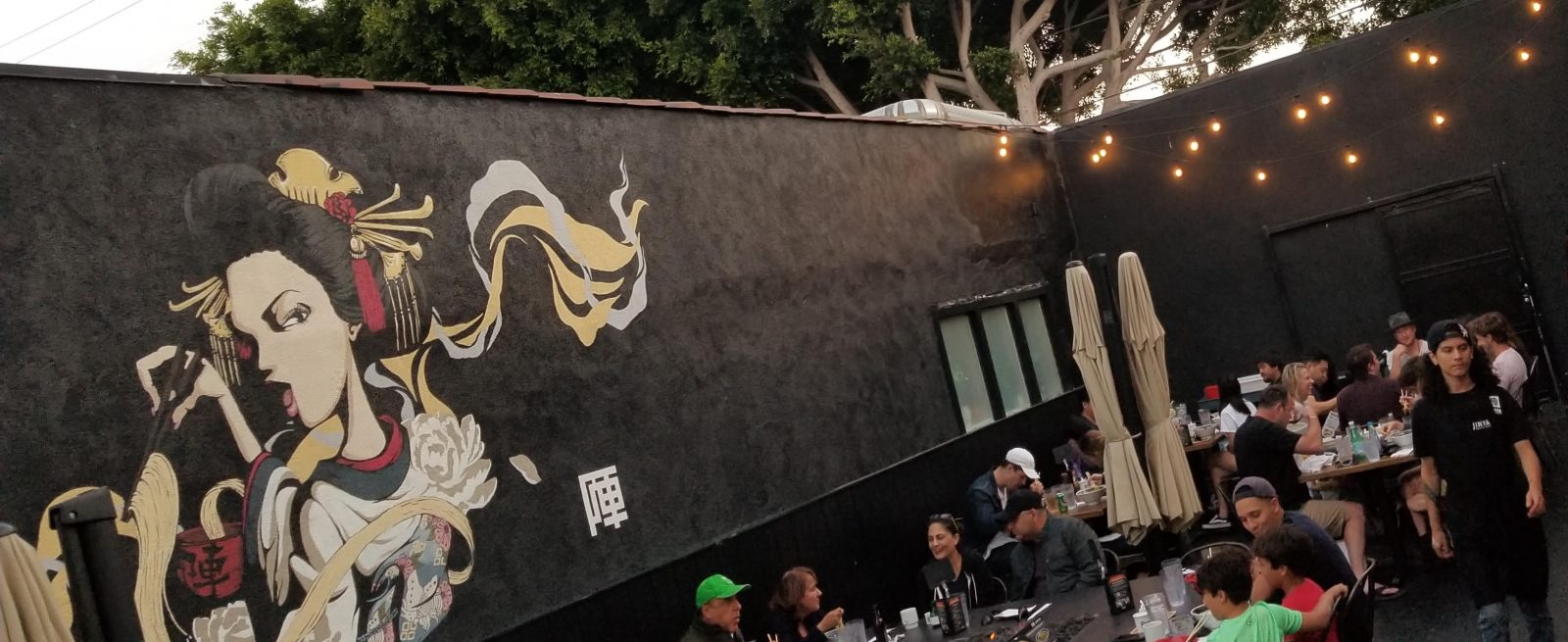MRM By Design: The Great Outdoors
14 Min Read By MRM Staff
Outdoor seating and other amenities have become top priority for restaurants looking to compete with their neighbors. In fact, outdoor seating can increase a restaurants revenue nearly 30 percent. A number of restaurant franchises have moved forward with concepts revolving around outdoor seating to highlight patio seating in their existing and new restaurants that are opening across the country.
Modern Restaurant Management (MRM) magazine spoke with executives from The Beerhead Bar & Eatery, Boston’s Pizza Restaurant & Sports Bar, JINYA Holdings and Quaker Steak & Lube about this trend.
The Beerhead Bar & Eatery
Why do you feel guests want outdoor dining? Have you noticed this trend upticking in recent years?
The Beerhead Bar & Eatery model includes a 1,500 square foot to 2,000 square foot patio as part of its standard restaurant build-out. Early on, the founders recognized (in large part due to their own personal preferences) that each spring when the blustery winter weather breaks in the Midwest, where their franchise is focused, restaurant goers seek out outdoor seating options. The atmosphere that can be created outdoors is difficult to replicate indoors (without bird cages and UV lamps strewn about). The longer and more dreary the weather, the bigger the rush to the patios each spring. Beerhead even makes it a practice to send daily reminders via phone, text, or email to operational staff when the weather is on the cusp of spring reminding our store operators to be ready to staff up for the pending rush. Invariably the first outbreak of temperatures greater than 50 degrees with sunshine is a patio packing event. The uptick continues throughout the spring and summer, and even early winter, in the Midwest with the last patio dweller typically yielding to indoors by Thanksgiving.

How do you feel the outdoor space reflects the trend of experiential dining?
What better way to enjoy the outdoors, than with a flight of beers or a giant pretzel or fresh salad!? Many craft beer outings have historically occurred in dark, dimly lit venues. While we still like to bring some of the craft beer community essence into our spaces, we also want our customers to enjoy the light and airy feel our outdoor patio spaces and open interior floor plans provide.
What are some of the advantages of offering outdoor dining?
One of the main advantages Beerhead has experienced with our patios is the diversity of the guests patios are able to draw. Guests whom otherwise may be intimidated by visiting an authentic craft beer bar and eatery (but are wanting to try) may feel more comfortable in the open-air feel patio spaces provide. Families, and their “best friends” our some of our most frequent patio guests — see #DogsOfBeerhead for a view of many faces that visit and enjoy our patios here at Beerhead.
How do you select what design elements to incorporate in an outdoor area?
Both our interior and exterior spaces are centered around community seating – large gather spaces and tables designed for different groups and share. The friendly and collaborative character of the craft beer community lends itself to having options for people to gather and meet and we have those both in our interior spaces and exterior patio spaces.
How do you try and reflect the brand and create a similar ambiance in an outdoor environment?
Community seating provided both inside and outside create a seamless transition from one to the other. Additionally, utilizing large accordion doors or garage doors in all of our spaces opens up the interior space so they seamlessly intersect with our outdoor patio spaces.
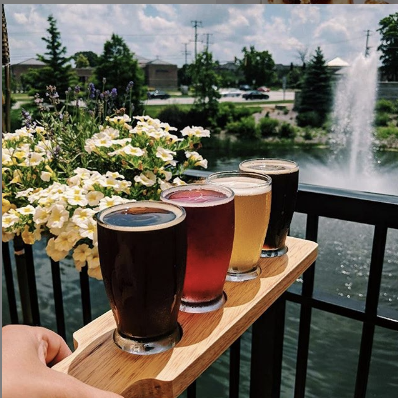
What are some of the challenges of outdoor dining regarding staffing and menu?
Because Beerhead spaces are relatively compact and quaint, our guests will experience the same great service and menu offerings both inside and outside on our patios. Though, from time-to-time an unanticipated rain or wind gust can provide a temporary inconvenience for patio goers that is parlayed into part of the fun of dining outdoors!
How do you feel offering more outdoor space has made the business more able to compete with other area restaurants?
Having that outdoor space is something that has always been a part of our concept. When people seek a Beerhead location they know they’re getting communal outdoor and indoor spaces, loads of craft beer, tasty food options, and an overall fun and relaxing environment – an authentic craft beer experience.
How important is creating a dog-friendly atmosphere for Beerhead?
We hold multiple events here at Beerhead that support local animal rescues, and our #DogsOfBeerhead is a hit for customers to interact with other pups who love pints! Our Beerhead locations are well known to be dog friendly and our guests enjoy and appreciate any opportunity to enjoy a cold craft beer with their “best friends.”
How important are events for the outdoor space?
Typically, the outdoor patio experience is enjoyable on its own, without any event or entertainment. However, from time to time Beerhead will host live entertainment or an event, such as a dog rescue event, that is suited for patio space.
Boston’s Pizza Restaurant & Sports Bar
Responses are from Adam Garner, Vice President of Operations and Jeff Melnick, Boston Pizza International Inc., President
Why do you feel guests want outdoor dining? Have you noticed this trend upticking in recent years?
Adam: Dining out remains an experience for guests. It’s a departure from their everyday routine, and patio dining represents an even greater break from the norm. I’ve noticed guests becoming more discerning about their outdoor dining choices. As restaurants have upgraded their facilities to cater to a more comfortable experience, guest expectations have risen proportionately.
Jeff: I am seeing more movement towards a lounge atmosphere versus just table and chairs. Millennials/those living in apartments or in and more urban spaces don’t have backyards. There is a cultural shift in people staying in, but something outdoors becomes more appealing.
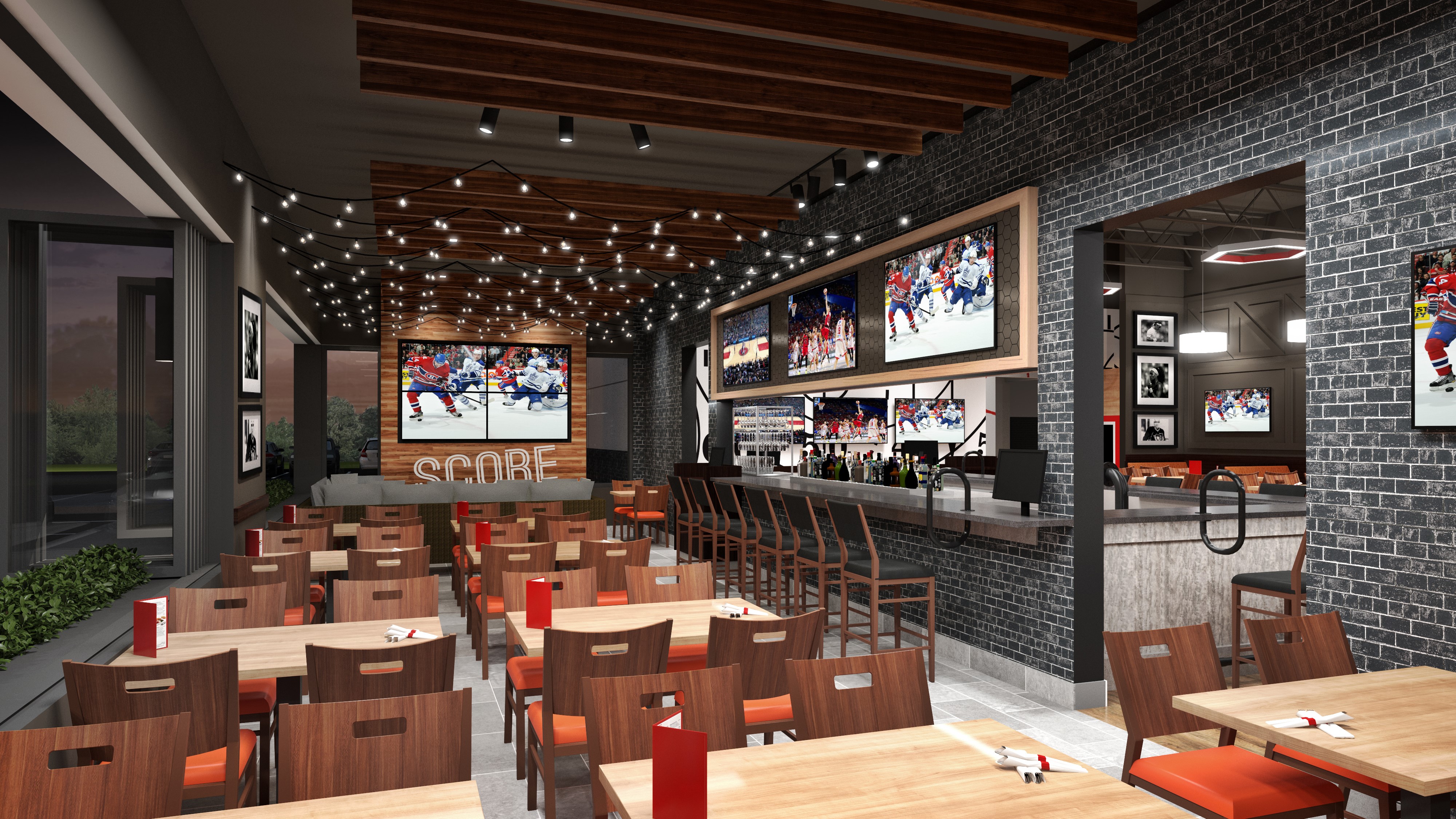
How do you feel the outdoor space reflects the trend of experiential dining?
Adam: Setting tables outside your side door simply isn’t good enough anymore. The outdoor space is as important as the interior space for the guest who seeks a superior patio experience. We are seeing significant investments in the patio as a primary consideration for business rather than a “nice to have” add-on that gets bolted onto the restaurant exterior. 4 season patios are allowing guests to enjoy their favorite patio year round regardless of heat or cold, wind or rain. This gives the guest an opportunity to break out of their daily dining routine anytime they wish and enjoy a differentiated experience. \
Setting tables outside your side door simply isn’t good enough anymore.
What are some of the advantages of offering outdoor dining?
Adam: From the guest perspective, patio dining really is all about a choice. A choice to dine in a way that is a departure from the day-to-day routine. It’s a chance to enjoy a great meal, with great friends and family, and enjoy fresh air and vistas that aren’t possible when surrounded by four walls. From a business perspective, the patio if often a big plus when considering sales per square foot as a key success metric. In most cases, for those who pay rent to a landlord, the square footage consumed by the patio space is not included in the rent costs of the building; fully enclosed patios are an exception to this as they are typically considered part of the full interior for rent purposes.
Jeff: Operators make the mistake of not having servers scheduled for the patio. Staff it and guests will come. Work hard to execute in outdoor spaces well to build momentum in sales. The patio often becomes a “pick up” space for existing servers.
How do you select what design elements to incorporate in an outdoor area?
Adam: The patio should be a reflection of the personality of the restaurant itself. If you operate a sports themed establishment, you better be able to watch and hear the game while on the patio! Ensuring comfort is among the most critical elements to consider in the design package. Heaters, fans, misters, fire pits, lighting, and A/V must all be carefully planned to ensure the guest can be comfortable in their decision to dine outdoors at your restaurant.
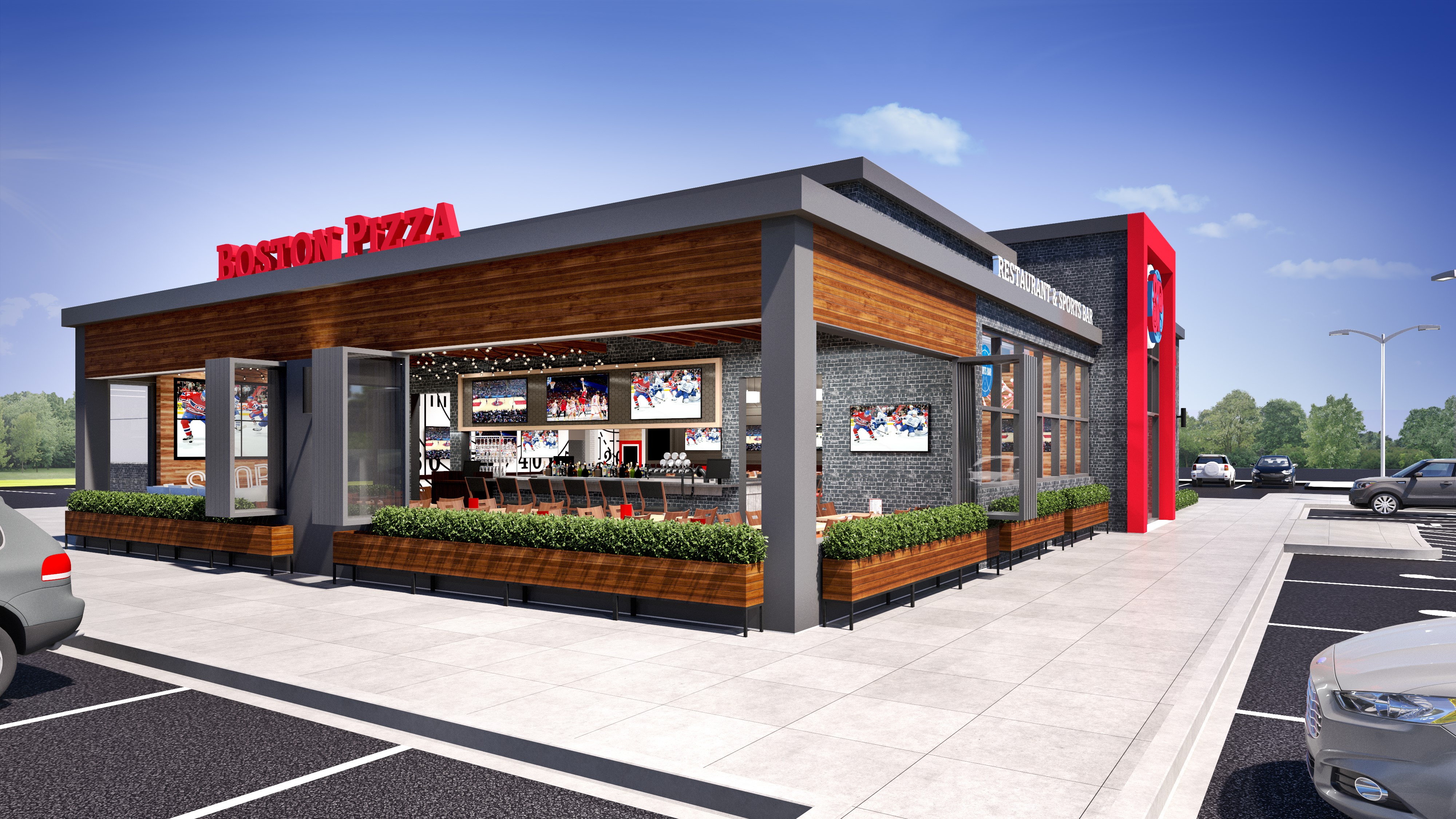
What are some of the challenges of outdoor dining regarding staffing and menu?
Adam: Planning. That’s that hardest part about the patio. It’s critical that the management team understand their specific seasonality, event trends, weather triggers, etc…to be able to accurately staff the patio and ensure the kitchen is ready to produce food for the extended seating capacity. The quickest way to kill your patio business is to provide slow service and cold food and warm drinks. If the guest feels ignored or marginalized because they have chosen to dine on the patio, they will make a different choice in the future. Not enough staff to service the patio, food sits too long in the expo window, and drinks get warm and watered down while waiting to be served; these issues will kill a patio quickly. Shortly you’ll stop staffing and there will be no patio business. Eventually an operator will be convinced that they simply aren’t a “patio type of restaurant.” It’s not always easy to ensure you’re staffed in both the HOH and HOF to offer genuine hospitality and service, but it’s critical to growing and maintaining this element of the business.
How much of an impact does bad weather have when outdoor dining is available?
Adam: Depending on the type of patio offered by a restaurant, weather can be a determining factor in a guest’s choice to dine outdoors. For those located in the northern states, they may close their patio during the winter and early spring months; others may have invested in a four season patio that allows them to operate year round and take advantage of the opportunity from others being restricted to offering outdoor dining in only more comfortable temperatures. Weather can also have an impact on the guest’s mindset as they make their dining choice. Remember, we all want to be comfortable; if you can be provided a truly comfortable and engaging experience on a patio while it’s raining and 40 degrees outside, you’ll win where many won’t even have a chance to play!
How do you feel offering more outdoor space has made the business more able to compete with other area restaurants?
Adam: When done well, this offers a true point of differentiation versus other options the guest may have. We focus on maintaining a lively sports viewing environment in a comfortable setting where guests can enjoy made from scratch food and wonderful drinks all served with genuine hospitality. We recognize the need to get out of the everyday routine and we embrace providing this option to our guests. This is what sets us apart in the patio space and allows us to offer something to our guests that they won’t find elsewhere.
How important are events for the outdoor space?
Adam: Our patios are perfect for booking events! From a business perspective it’s easy to separate the space, create a private experience, and maintain a great atmosphere for the rest of our guests in our lounge and dining room. Leveraging the patio space for group events is essential to driving repeat business, creating a sense of “the place to be,” and to a certain extent, such events are their own advertising.
For Boston’s, can you give a few examples of the different outdoor spaces and how they work in each environment. (or future concept)
Jeff: The four season patio is becoming an exciting element in our design plans. It allows the operator and guests to use the patio year round regardless of temperature or other weather factors. When the weather is beautiful, the exterior windows and walls open up to allow the fresh air and sun shine to fill the space; when the weather is less pleasant, the guests are still able to enjoy the views of the outdoors while being protected from the elements. This gives our guests the option to choose patio dining anytime they’re in the mood! For our legacy restaurants, you’ll see a combination of covered patios and even an open patio concept that really embraces a festival atmosphere. Set up big tents, community tables, bring out the band, and recruit your local brewery to host the beer garden and you have a community event that will attract guests from near and far!
Are there any significant concerns over possible liability regarding fire pits?
Adam: We have not encountered any issues with our fire pits. Our guests enjoy the mood they create on the patio. Sometimes it’s not always about heat, it’s just about being made to feel more at home. We don’t foresee challenges in the future with this patio feature.
Jeff: we will continue to have some element that enhances the atmosphere but it evolves based on guest preference, location/weather trends, and also our franchisee’s preference in the build out. As a franchisor, we offer a lot of flexibility and work with our owner/operators to come up with plans that fit their business needs in that space.
JINYA Holdings
Responses are from Tomo Takahashi, Founder and CEO, JINYA Holdings.
How do you feel the outdoor space reflects the trend of experiential dining?
Guests want to experience a genuine sense of place, and being outdoors provides that ambiance.
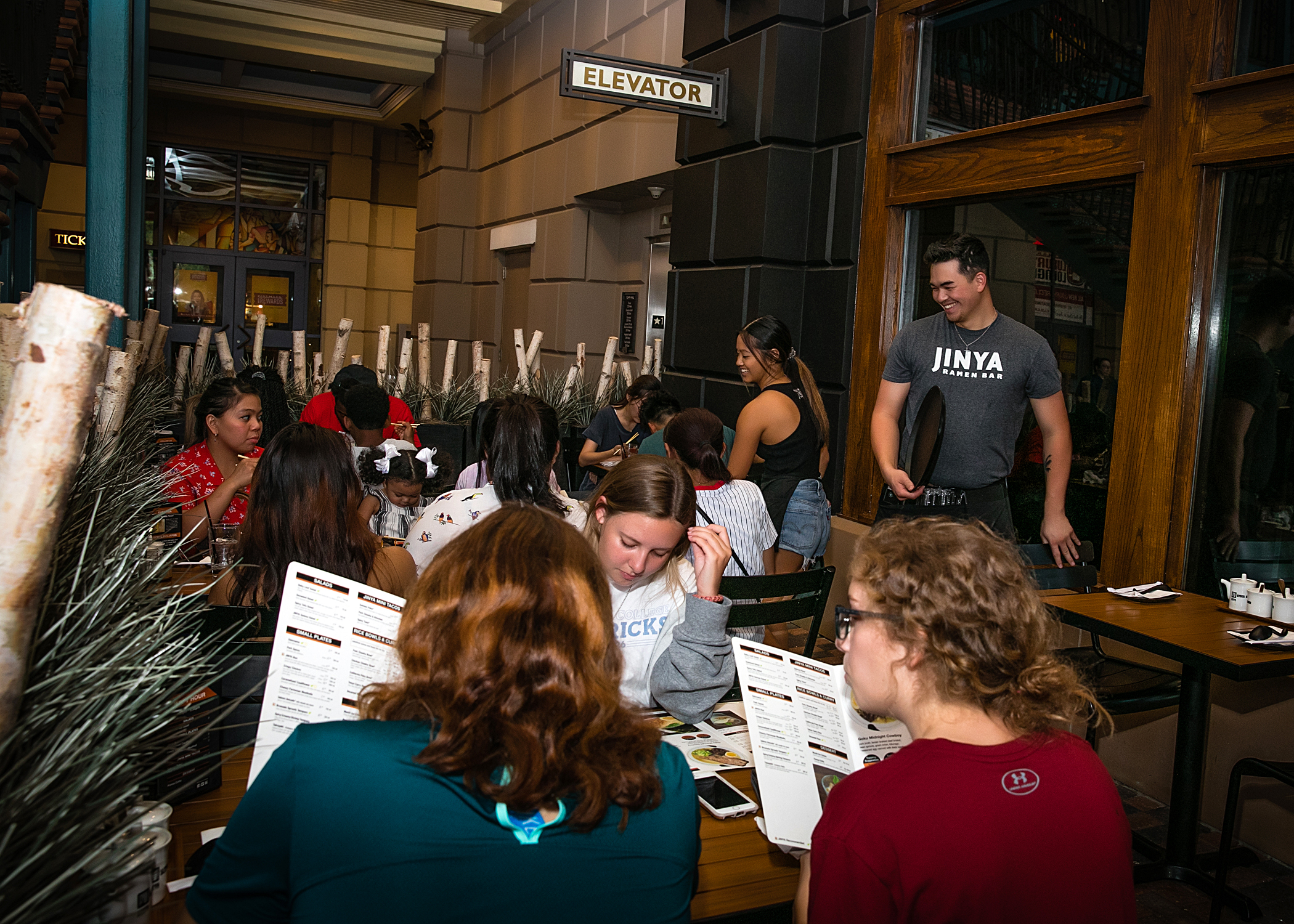
What are some of the advantages of offering outdoor dining?
In several locations, we are able to expand our seating, without changing the dimensions of an original indoor structure. We are also able to provide different experiences to our guests.
How do you select what design elements to incorporate in an outdoor area?
Restaurant design is an art at JINYA. If we have space outdoors, we have an outdoor fire pit surrounded by seating. This an exciting dining experience at our locations such as Santa Monica, California or Bethesda, Maryland. We are thoughtful about design. JINYA always wishes to design elements that work in harmony.
What are some of the challenges of outdoor dining regarding staffing and menu?
We need to ensure that the guest service is consistent between indoor and outdoor. Delivery times from kitchen to table need to be consistent.
Quaker Steak & Lube
Responses are from Bruce Lane, VP of Operations and Franchise Services.
Why do you feel guests want outdoor dining? Have you noticed this trend upticking in recent years?
For most guests, al fresco dining isn’t just about having a meal; it’s about the experience. Most Quaker Steak & Lube restaurants are located in the northeast and Midwest states that see harsh winters and leave people cooped-up indoors for months. Once it’s warm enough to sit outside and enjoy warm weather, many folks want to do as many activities as they can outside, including dining. Outdoor dining also provides a more casual home-like feel and experience leading guests to stay a while longer. Many Quaker Steak & Lube restaurants have large patios with plenty of space for live music, adding to an even greater guest experience.
Additionally, many of our restaurants host Bike Nites and Car Cruise-ins, where guests dining on the patio can engage with those events. Not all guests want to dine outside, however, so it’s great that we have the ability to give them the option of indoor or outdoor seating. Some of our original concept restaurants also have three-season rooms and some have added enclosed patios. In the south, options such as misters on the patio and sliding glass doors keep guests out of the elements, but provide an outside space. The trend in outdoor dining is increasing for the reasons stated above — guests want to enjoy the outdoors as much as possible.
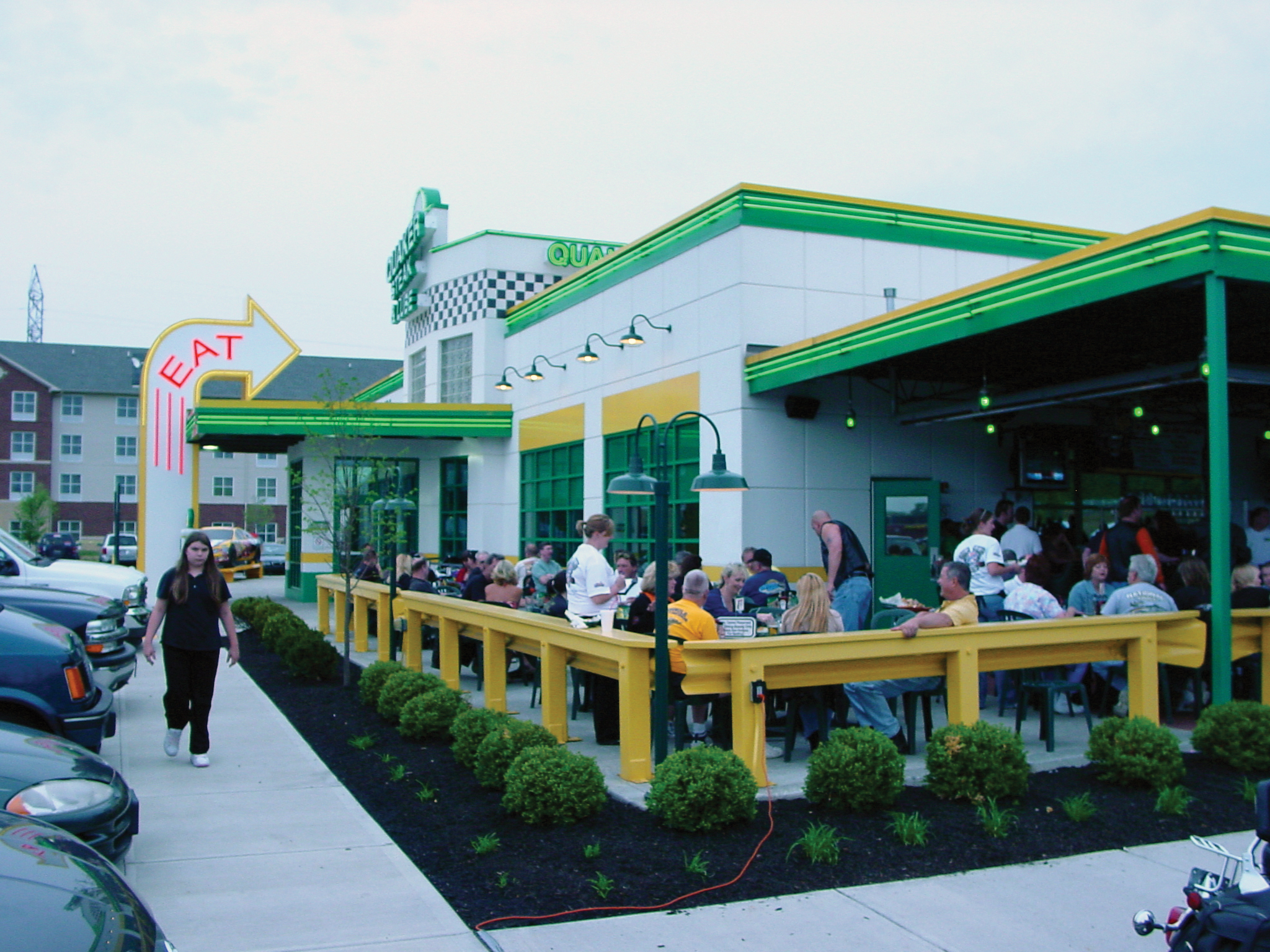
How do you feel the outdoor space reflects the trend of experiential dining?
At the core of experiential dining are guests who want to enjoy themselves and make memories. At Quaker Steak & Lube, we want the atmosphere to be relaxing, but we are also known for our high-energy outdoor events such as Bike Nites, Car Cruise-ins, live music and more. We are introducing fire pits and lounge areas for people to gather and relax. Whether it’s a group of guests coming in for drinks, or those who wish to sit and enjoy the ambiance after dining, guests will gravitate toward these comfortable, home-like areas. Quaker Steak’s new concept allows us to open up a wall to provide a bar to the outside patio. In both the traditional floorplan and the new concept, patios are not just an “add on,” they are core to our brand and the experience we provide.
What are some advantages of outdoor dining?
Giving the guest variety and the option to choose indoor or outdoor dining is a key advantage for them. Additionally, at Quaker Steak we manage our outdoor spaces the same as we do inside to ensure a quality experience for all guests. Some restaurants treat their guests in outdoor areas as overflow and aren’t staffed appropriately to accommodate them, which leads to a negative experience for front of house, back of house and the guest. For restaurant operations, having a large number of outdoor seats provides a good return on investment in terms of occupancy costs since we are not paying addition fees for the outdoor seating.
How do you select what design elements to incorporate in an outdoor area?
We want outdoor seating to be flexible and accommodating for our guests. With that in mind, many Quaker Steak patios have hardtop roofs and accordion style or glass windows and walls that can be closed during inclement weather. This allows the space to be used at all times without weather monitoring. With many of our restaurant locations in the northeast and Midwest areas of the country, we build in flexibility in order to get the most use of our patios.
How do you try and reflect the brand and create a similar ambiance in an outdoor environment?
Many people come to Quaker Steak & Lube for the atmosphere and unique décor, including automotive and motorcycle themed memorabilia, which is incorporated into our outdoor seating areas. A perfect example of this is the full size motorcycle built into the fence around the patio on the new restaurant design. Not only does this fit the brand’s motor theme, it gives guests a unique photo opportunity to memorialize the event and share with friends. The new building concept also incorporates light posts on the patio that are made to look like old highway signs. We want guests to feel they are still at a Quaker Steak restaurant, while enjoying the outdoor environment.
What are some of the challenges of outdoor seating regarding staffing and menu?
Our main challenge is the weather. It gets very cold in the northeast part of the country, rendering many of our outdoor spaces unusable. Even if they have windows or roofs, those are in place to enable outdoor dining during rain while it’s warm — it’s generally not warm enough in those areas during the middle of winter. Some restaurants also have satellite bars, which are enclosed bars away from the main building. These satellites usually shut down for the winter and have to be winterized in order to prevent beer and soda lines from freezing and getting damaged. Similarly, outdoor restrooms with waterlines need to be winterized. When our outdoor areas are open, we staff and manage them the same as our indoor seating areas, so we generally don’t have challenges with staffing or menu options.
How do you feel offering more outdoor space has made the business more able to compete with other area restaurants?
Our outdoor spaces give customers a very home-like and neighborhood feel. Additionally, Quaker Steak & Lube is a family-friendly restaurant, so our outdoor areas are appropriate for all ages. Our goal is to create an outdoor area that gives guest the feeling that they are in their own backyard. This allows parents to relax while kids can have the chance to get up and move around — it’s less restricted than indoor seating. Some locations even have outdoor games set up, giving kids more freedom. At our Bristol, Va. Location, which is located on the main drag through town, guests can dine on the patio while watching passersby and enjoying the charm of the downtown area.
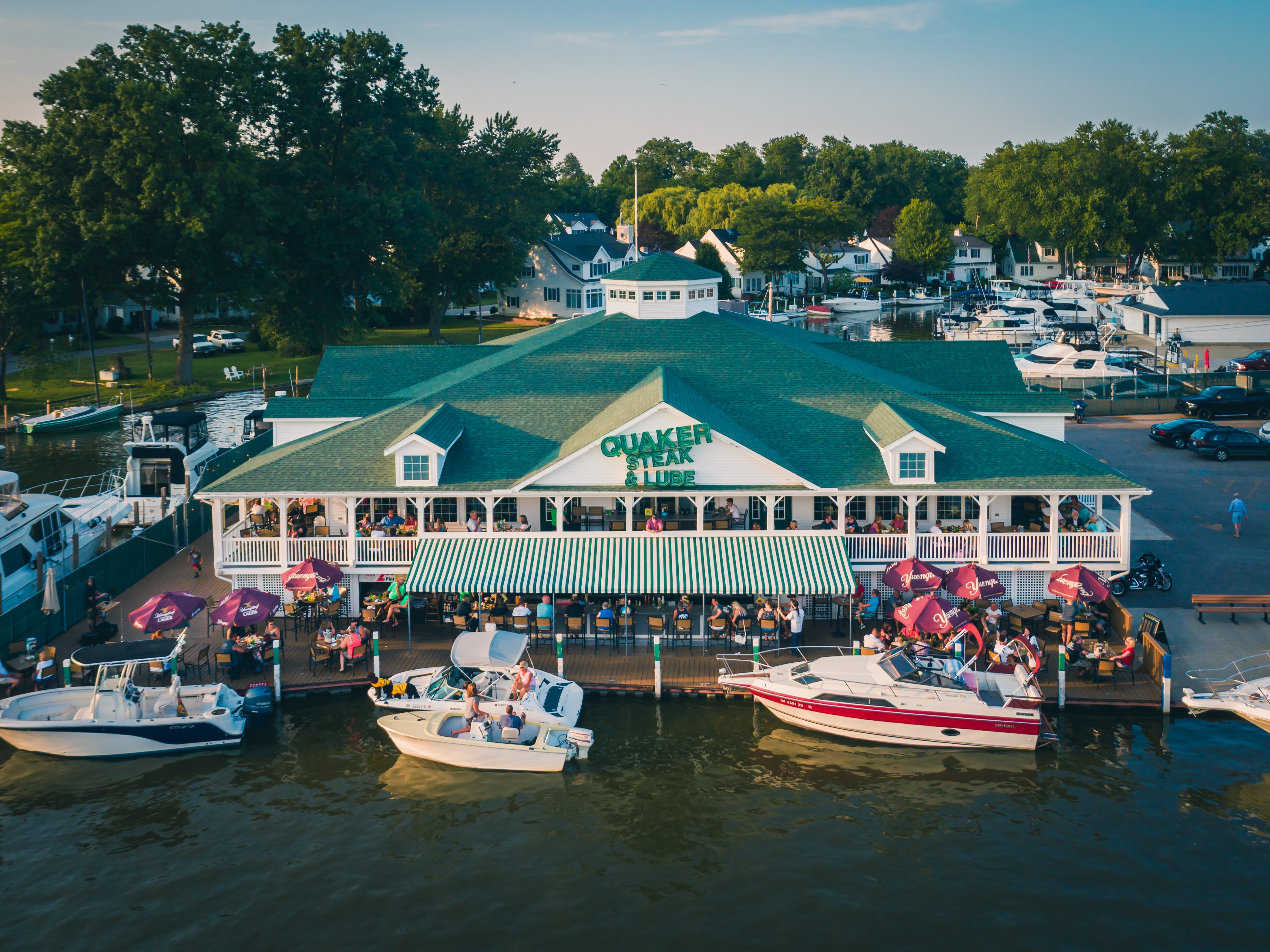
How important are events for the outdoor space?
Outdoor events are incredibly important for Quaker Steak & Lube. We have locations that may bring in $8,000 in sales on a normal Wednesday, but a Wednesday with an event could bring in as much as $28,000. Typical events include our famed Bike Nites that can easily attract 500 motorcyclists and bike enthusiasts. We also hold Car Cruise-ins at many of our restaurants, where proud owners can put their cars on display while they dine and meet with fellow car buffs. We’ve partnered with iHeart Radio to hold patio concerts that have brought in 4,000 guests. Some restaurants are limited with events they can hold due to city regulations so we try to get creative to work within those ordinances. When we are working with a new Quaker Steak franchisee to develop the layout for their restaurant, we factor in the space needed for events. Our franchisees understand the value of these events and embrace them as sales drivers. We want all of our franchisees to receive the most benefit from this vital revenue stream. There is an art to putting the restaurant on a piece of land that will generate extra revenue with planned events.
For Quaker Steak, can you give a few examples of the different outdoor spaces and how they work in each environment?
We have a new franchise restaurant being built in Raphine, Va., and the franchisee has a love for cars and entertaining. The owner has a personal car collection that he is going to turn into a car museum on the same property with his Quaker Steak & Lube restaurant. He’s also going to put in a grassy area next to the patio that will be used for concerts, with a space for a stage setup. Another Quaker Steak restaurant, in Vermilion, Ohio, is located on the water allowing boaters to pull up, dock and come in. That location has a bar on one of the docks making it a popular summer destination in the area. Each restaurant has its own uniqueness based on its location and the community. We work with our franchisees to incorporate fun and different brand attributes to their locations that will help them achieve success in their local markets.

